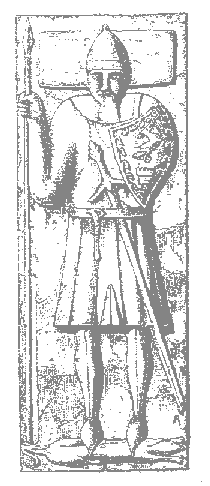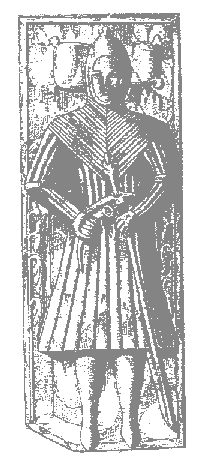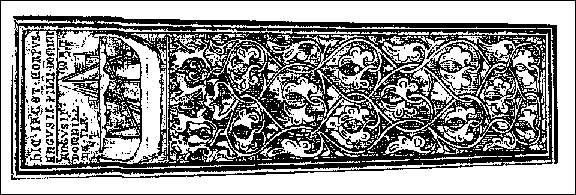On the northern side of the Wooler to Kirknewton road (B6351), where it crests a small knoll rising amidst bare Northumbrian fields , stands a monument marking this as the site of one of the most evocative archaeological sites in Northumberland. It is also a record of one of the most remarkable archaeological discoveries of the 20th century.
Around 1300 years ago timber halls stood here marking the site of the royal residence of early Anglo-Saxon kings. In AD731, and shortly after its abandonment , the scholar and saint, Bede, records that while king Edwin and his queen were residing here, the queen’s bishop, Paulinus, baptised many in the nearby river Glen.
Thereafter the precise location of the settlement was lost, and it passed into legend.
In 1949 Professor J. K. St. Joseph was employing the relatively new techniques of aerial photography to search for Roman military camps in the region. A severe drought made conditions ideal for aerial archaeology. As he flew over the Glendale area he noticed, and photographed, an impressive series of crop marks in an otherwise undistinguished field. More crop marks were seen further north near Milfield. In time a full aerial survey was made.
 Between 1953 and 1962 a detailed archaeological excavation to the site was undertaken by a young Cambridge scholar, Brian Hope-Taylor. Although marks of buildings were observed to both the north and south of the present day road it was in the field to the north of the road where attention was focussed. Here the land rises and forms a gravel whaleback which would have stood clear of the marshy terrain present in the area when Gefrin was conceived. This area would have been the natural through route for travelers at the time. Today, with efficient field drainage, the Milfield plain is a lot dryer than it once was.
Between 1953 and 1962 a detailed archaeological excavation to the site was undertaken by a young Cambridge scholar, Brian Hope-Taylor. Although marks of buildings were observed to both the north and south of the present day road it was in the field to the north of the road where attention was focussed. Here the land rises and forms a gravel whaleback which would have stood clear of the marshy terrain present in the area when Gefrin was conceived. This area would have been the natural through route for travelers at the time. Today, with efficient field drainage, the Milfield plain is a lot dryer than it once was.
The excavations revealed a complex of great halls or palaces, some over eighty five feet (26m) in length, of timber construction and built to a very high standard. Ancillary buildings such as kitchens, a weaving shed and what the excavator believed to have been a pagan temple converted to Christian use. The palace complex was designed to accomodate elements of the earlier landscape notably two burial monuments and the massive 'Great Enclosure'.This Great Enclosure's prime function is thought to have been as a kraal for cattle brought to the site perhaps as taxation or to be consumed during feasts. It is equally possible that it's use was related to horses. Enormous quantities of horse bones, including complete skeletons, were found outside the main entrance during the construction of the railway in 1885.
 A large timber grandstand or outdoor assembly building is one of the remarkable features of the site. The graphic here is adapted from an illustration by Brian Hope-Taylor. Although referred to as 'The Theatre' you will note from the size of, what would be, the stage that this was, in all probability, the seventh century equivalent of a modern lecture theatre, perhaps a parliament building.
A large timber grandstand or outdoor assembly building is one of the remarkable features of the site. The graphic here is adapted from an illustration by Brian Hope-Taylor. Although referred to as 'The Theatre' you will note from the size of, what would be, the stage that this was, in all probability, the seventh century equivalent of a modern lecture theatre, perhaps a parliament building.
The King and his retinue would move around the kingdom staying at a number of settlements like Ad Gefrin. Sprouston and Thirlings may be other local examples.

 They created a stronghold, Dunyvaig Castle, on the eastern side of Lagavulin Bay on a coastal promontory to control the coasts of Kintyre and Antrim. The site for the stronghold was on top of remains from a fortification which dates back to earlier times. By 1153 Somerled’s relation with the king of Scots became worse and in 1164 Somerled invaded the mainland and sailed up the Clyde with 160 galleys, but met his end at Renfrew. Somerled’s lands were divided amongst his three sons, Ranald, Angus and Dougall. Ranald ruled in Islay and Kintyre, adopted the title “of Islay” and called himself king of the isles and lord of Argyll. The land of Angus was later given to Donald, the son of Ranald, and to Dougall. Thus Somerled was the progenitor of both Clan Donald and Clan Dougall. Where the MacDougalls co-operated with the Scots Crown, the MacDonalds didn’t and even joined King Haakon’s 1263 expedition against Scotland. Later in 1266 the isles were held by Alexander III, King of Scots whereas the former vassals of the king of Norway were left in possession of the isles. The MacDougalls however were in favour and later kept on supporting the king of Scots whereas the MacDonalds were on the English Edward I side. But in 1306 during the civil war, the MacDougalls sided with the English in opposing Bruce which however turned out to be the loosing side and thus the Clan Donald, by supporting Bruce, came out stronger than before. Later Robert I destroyed the MacDougalls and granted much of their territory to the MacDonalds which gave them a strong position in the years to come.
They created a stronghold, Dunyvaig Castle, on the eastern side of Lagavulin Bay on a coastal promontory to control the coasts of Kintyre and Antrim. The site for the stronghold was on top of remains from a fortification which dates back to earlier times. By 1153 Somerled’s relation with the king of Scots became worse and in 1164 Somerled invaded the mainland and sailed up the Clyde with 160 galleys, but met his end at Renfrew. Somerled’s lands were divided amongst his three sons, Ranald, Angus and Dougall. Ranald ruled in Islay and Kintyre, adopted the title “of Islay” and called himself king of the isles and lord of Argyll. The land of Angus was later given to Donald, the son of Ranald, and to Dougall. Thus Somerled was the progenitor of both Clan Donald and Clan Dougall. Where the MacDougalls co-operated with the Scots Crown, the MacDonalds didn’t and even joined King Haakon’s 1263 expedition against Scotland. Later in 1266 the isles were held by Alexander III, King of Scots whereas the former vassals of the king of Norway were left in possession of the isles. The MacDougalls however were in favour and later kept on supporting the king of Scots whereas the MacDonalds were on the English Edward I side. But in 1306 during the civil war, the MacDougalls sided with the English in opposing Bruce which however turned out to be the loosing side and thus the Clan Donald, by supporting Bruce, came out stronger than before. Later Robert I destroyed the MacDougalls and granted much of their territory to the MacDonalds which gave them a strong position in the years to come.


You need to be an initiate of Celtic Magic to add comments!